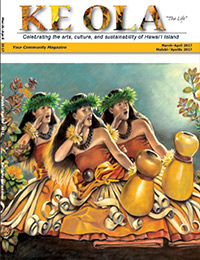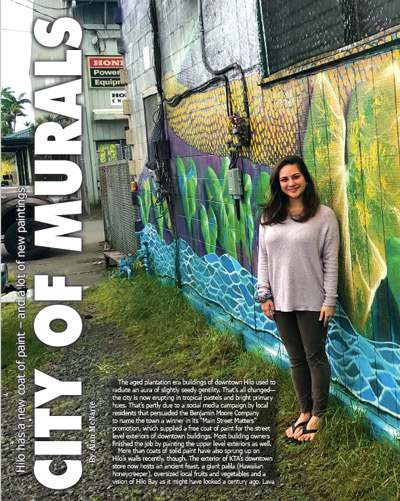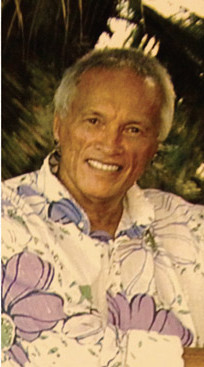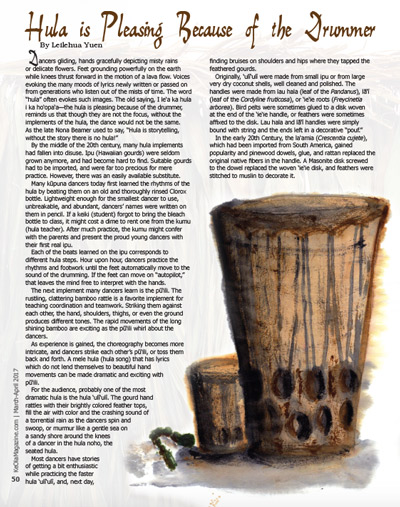Komakakino: A Hilo Cultural Treasure on the Music Scene
By Paula Thomas
They have stepped forward as keepers of the future flame, this band from Keaukaha. Called Komakakino, the band is a foursome that performs and entertains with traditional Hawaiian music from days of old. And they are simply, sweetly amazing.
The band’s name is a lyrical blend of the founding members’ first names: Koma, Namaka, and Kinohi. It seems fitting, as these three young men have been dancing hula together in the hālau of Kumu Paul Neves for years and have known one another since childhood. Namaka and Kinohi both attended Ke Kula ‘O Nawahiokalani‘ōpu‘u while Koma attended Kamehameha Schools. Yet it wasn’t until 2010 that they came together to play music; to blend their passion, their culture, and mana‘o (ideas) and bring it forth for stage-ready entertainment.
They are like brothers, so comfortable in their skin in one another’s company. It’s this ease in togetherness that you can feel when they perform.
For all of them, music played a strong role in family life. Mostly it was exposure to music from elders who either performed themselves or participated in musical events. Love of music sharpened their ears for listening to everything in a song: how the voice modulated, where and how the emotion came forth, chords, rhythmic structure, and the wholeness of the musical experience. With very little formal training as musicians, they learned mostly by listening and experimenting.
Koma, whose full name is Kyle Reid Koma Wana, is the seasoned instrumentalist. He came to the group already playing guitar and ‘ukulele and taught Namaka (Michael-John Kekeikiinamakaho‘olili De Mello) and Kinohi (Kinohi Pukaua o Kamehameha Neves), the son of Kumu Paul Neves.

Now, each not only play guitar and ‘ukulele, but also bass, thanks to sessions with musician Kuana Torres Kahele. They laugh about the process of learning the bass and having a hard time plucking strings with not-calloused-enough fingers. Christian, James Christian “Huliluna” Wadlington, is the fourth member who joined the band about three years ago. His gifts with steel guitar round out their Hawaiian sound.
As their voices blend seamlessly together in falsetto harmonies, they are equally unified with instrument exchange in any given song, with the exception that Christian is always on steel guitar. With the singing, as Namaka noted, “you can express what you feel without actually saying it.”
Their inimitable talents blend in service to performing traditional Hawaiian music, the brand of this band through which they honed their sweet falsettos, choral-like unity, and gentle, flowing sound that seems to come from the depths of their soul. And while they are on a mission to preserve and re-popularize this fabulously rich and iconic music, these artists also appreciate jazz and rock music from the 60s and 70s and have expanded their repertoire to include a range of cover songs. (I was treated to a rendition of Luther Vandross’s “If Only for One Night” in their distinctive style.) They’ve also stepped forth to write original music.
“That’s hard,” notes Koma, who feels more comfortable composing music than lyrics. But when they are making something original, they all work together. Their second CD, E Nipo Mai, is inspired by Mauna Kea and an experience they all had on a pilgrimage up to the summit to pray.
A Distinctly Hilo Style
Kuana Torres Kahele, originally from Pi‘ihonua, Hilo, commends and celebrates the uniquely Hilo sound of Komakakino in his tribute to the band: “There is something about growing up on the slopes of Mauna Kea that humbles a person. The mountain creates a perspective from which you measure yourself and shelters you from all of the impurities of the outside world.”
It is this sheltering that may be what has contributed to a distinctly Hilo sound in Hawaiian music, and Komakakino has it. Kuana Torres Kahele remains an inspiration to the group because of his vocal and composition skills and his unique, out-of-the-box perspectives.
“I am so optimistic for the keepers of our future flame. It is this passion and originality that has defined our community and elevated our sound. No one exemplifies this uniqueness more today than Keaukaha’s own Komakakino. Hilo’s offering of simple greatness in an overcomplicated, often duplicated world.”
“Simple greatness” is a phrase to ponder, to consider for its meaning. For while everything about Komakakino feels easy, open, humble, joyful, like a healthy and congenial camaraderie, there is something also profound in this togetherness. There’s an intimacy there and a respect that stems from the deep roots of the music and their mission to preserve this aspect of their Hawaiian heritage. Unlike the performers of old who may have performed the same songs, the members of Komakakino understand every word they speak. They are aware of the hidden meanings in the lyrics, the way the words play with references to beauty and love. And with that knowledge, they can feel through the song to connect emotionally to the audience.
When I spoke with them on a Wednesday, the night they typically rehearse, we just sat on the lānai and talked story while Kumu Paul listened in from the adjacent room. The love and aloha shared between these men is palpable—an organic, brotherly connection between them all. And despite the fact that Christian wasn’t able to be there in person, he was included in conversation as though he was there.
It was Kumu Paul who recruited Christian during one of his walks in Lili‘uokalani Park in December of 2013. Christian was sitting on a bench playing steel guitar with a friend on his birthday. Kumu Paul, drawn to the music, ventured over and stood behind him. Next, Kumu Paul got on the phone with his son, Kinohi. Kinohi found himself listening to steel guitar music having no idea why.
Christian showed up at the band’s gig—the County of Hawai‘i building for a Christmas party. As he tells it, “I chose to wear black shorts and a green aloha shirt that matched the band’s uniform choice for that evening. I couldn’t believe I was jamming with such talented Hawaiian musicians. It was a dream come true. That dream was a large part of what brought me to Hawai‘i in the first place.”
He has been with the band ever since. The nickname “Huliluna” stems from Kumu Paul who, wanting the steel guitar to be louder, told Christian to “Huli Luna! “Turn it up!”
A Mission to Entertain
Kumu Paul plays a quiet, guiding role in the band’s development. Just as he sat in the adjacent room to listen, he is ever watchful of the band as they develop and evolve as musicians, performers, and entertainers. “Komakakino is not just a band that performs. They have to also entertain,” he says. “Otherwise, they are just a group of men singing on a stage, and that’s not so interesting,” he says. “When you dance hula, you have to connect your body and your feelings to the audience. It’s all about the relationship with the audience. With Komakakino, it’s the same. There has to be some connection with the audience through the music,” he states. “It’s all about that connection.”
It’s a common understanding that an appreciative audience will stay for an entire performance. On the other hand, when a performance dissatisfies, it’s not uncommon for people to walk out. “Hawaiians vote with their feet,” Kumu Paul explains. “We may not be great at the polls, but we are good at judging performances, and the kūpuna will walk out if they don’t like what they are seeing. No one walks out when Komakakino is playing,” he notes. “They are the best bridge between the older generation and the younger generation through their music.” And have that distinct Hilo sound.
In 2017, they are working on more opportunities to perform locally. For now, they are regulars at the Hilo Hawaiian Hotel during Merrie Monarch Week, at Moku Ola (Coconut Island) on Kamehameha Day, and at Lili‘uokalani Park on the birthday of Queen Lili‘uokalani. They play at weddings, funerals, parties, and festivals. As busy as they can be, none of them expect to make a living through the band. “It’s hard these days to make a living as a musician and performer,” Kinohi says. “We all have regular day jobs.”
It was exciting to learn that their comfort level with one another and growing confidence is manifesting in more improvisation, the occasional musical solo during performances, and more original writing. This is the arc of a maturing band. “We want to be like the Beatles,” Kinohi says with a wry smile. “We also want to connect with people through the music and remind them of what to hold on to.”
When it comes to getting out there as performers, Komakakino has two CD’s out. The first is ‘O Kēia Ka Manawa, the second is E Nipo Mai, produced by Jaz Kaiwiko‘o and released through his record label, The Lahui Project.
Kumu Paul is the executive producer and main decision maker for the band, overseeing the financing, supporting the vision setting for the sound, the look of performances, and the production and marketing of the CD’s. He is a cultural practitioner who emphasizes Aloha as a lifestyle within a hālau setting, with ‘ohana (family), alaka‘i (leadership), and lōkahi (unity) as a foundation for communal expression. Kumu Paul has a goal of making a difference in the world today through the practice of Hawaiian culture and values. His leadership leaves the band to do what they do best—to create music and continue to hone and polish their technique and talents for entertaining.
It’s all about connecting with the audience—and as young as these band members are, let’s hope they will be able to this for years and years to come.
Photos courtesy of Komakakino
Contact Komakakino: 808.937.8575 ; nahalauhaaokea.org
Contact writer/photographer Paula Thomas: paula@delphipacific.com
‘O Kēia Ka Manawa
First CD released in 2013
| Makana o Keaukaha Kiss Me Love Palani Hula Ke Kali Nei Au ‘Eulopa Kou Maka U‘i Ke Aloha Kupaianaha |
‘O Kēia Ka Manawa Poli Anuanu Nāhikulani Kūpuna Party Tusitala Kūwili Keaukaha Ku‘u Home Ia |
E Nipo Mai
Ranked #11 on the mele.com top 50 albums of 2016
| Ho‘onanea Na Hua Kawahineha’aheo Komokakino Medley ‘Eulopa Ka‘ina |
Sweet Leilani Makamae Opaeka‘a Kauoha Mai Maui Blue Rose Lokoaka |
Komakakino’s Free Performances in 2017
Last Friday of every month: 5pm–7:30pm, Grand Naniloa Hotel, Hilo
April 21st: 1pm–3pm, Hilo Hawaiian Hotel, Merrie Monarch show, Hilo
June 11th: 1pm–2pm, Moku Ola/Coconut Island, Kamehameha Day, Hilo
September 2nd: time TBA, Lili‘uokalani Day (free to the public), Hilo
November 11th: 5pm Hilo Palace Theater, Hālau Presentation for Queen Liliʻuokalani Celebration of Life (tickets required), Hilo



